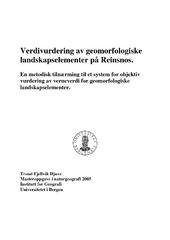| dc.description.abstract | This thesis is about the value of difference, diversity and distinctiveness in abiotic nature, presented in this paper by the concept of Geodiversity, focusing on geomorphological features. The overall aim of the thesis is to provide a helpful tool in geoconservation based on a methodological approach supported by a case study from Reinsnos, which lies within the administrative boundaries of the municipality Odda in the western part of Norway. By combining geomorphology and conservational approaches a system is presented that deals with evaluation of geomorphological features in terms of their scientific value. Geomorphology and the mapping of landform distribution resulted in a detailed quaternary geological map of the study area. Through a strict scientific approach and a clear methodological framework the problem with subjectivity in this kind of research is sought to be kept at a minimum. The geomorphological features are interpreted after their value based on their degree of fulfilment of 13 parameters that measures their value. These parameters focus on measuring landforms in terms of different aspects that measures their scientific value (process, reference area, representativeness, rareness, size and clarity, key area, part of a greater context, condition, vulnerability, research value, pedagogic value, availability and functional value). Through quantification of these parameters (A=40, B=30, C=20 & D=10) an objective system of evaluation is presented and it is possible, through different statistical approaches, to evaluate single features or complex areas according to different aspects of their value. Based on the quantification and value the features are placed in four categories (Category 1-4). The case study presents the value of the area and its individual landforms according to the methodological guidelines given by the thesis. There are a total of 34 registered localities, differing from small features less than one m2 to large-scale forms consisting of whole valleys or mountains. There are no landforms valued high enough to qualify for category 1, eight landforms in category 2, 19 in category 3 and seven in the last category. The parameters representing the highest valued qualities for the area are availability, condition, pedagogic value and process. The diversity of the area is represented with 21 unique landforms out of a total of 34 localities, representing six major landform features. Glacial landform is the highest represented group with six unique landforms out of a total of 15 localities. The mean total value for the area is 21.1 which places Reinsnos as a category 3 area. This means that the area, according to the system presented, has a high scientific value for a regional understanding of the processes that shaped and are still influencing the landscape, but other landforms and areas in the region better represent the same scientific features. The thesis concludes that the system presented for an objective, quantitative evaluation of geomorphological features in terms of their scientific value is useful and is a contribution to the work of geoconservation, and the objectivity is to a certain extent retained. | en_US |
